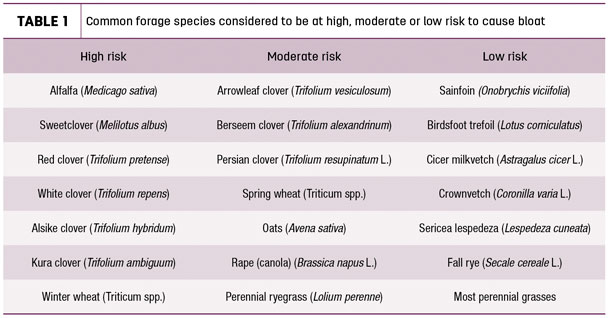Bloat is caused by fermentation gases being trapped under a foamy mat in the rumen, and it is often associated with livestock grazing alfalfa, clover or wheat pastures. Perhaps by better understanding bloat, how to prevent it and treat it (should the need arise), livestock producers can overcome a fear of bloat.
The factors
The cause of frothy bloat is the build up of a foamy mat that floats on top of the contents of the rumen and reticulum, the first two compartments in the ruminant animal’s four-compartmented stomach. This foam catches the gases that result from the fermentation of the digesta, and it builds up pressure to a point where the affected animal struggles to inhale and exhale normally. So to understand the cause of bloat, one must understand the factors that cause this foamy mat to be created.
Though there are still many aspects of how this foam forms that baffle scientists, there are three primary factors known to be required for it to occur. The first of these factors include highly digestible, high-protein forage, like that which is found in alfalfa, clover, wheat and other forages known to be at high risk of causing bloat (Table 1).

When high-protein forages are digested rapidly, the rumen fluid very quickly becomes more viscous or thick. This thickness slows the gas bubbles from bubbling up to the top of the rumen fluid and contributes to the formation of the foamy mat. In fact, most bloat-preventing feed additives or treatments, such as detergents and oils, help by reducing the surface tension and lowering the viscosity of the rumen fluid.
Many of the low-risk species listed in Table 1 are high in tannins. High-tannin forages prevent bloat because the tannins bind with broken bits of the plant proteins. This keeps those proteins from causing the rumen fluid to get thick.
A second factor is the presence of an abundance of fine particles in the rumen-reticulum. If the forage or feed is highly digestible, there will be many tiny parts of plant cells floating around in the rumen fluid. These tiny pieces tend to catch gas bubbles as they bubble up through the rumen fluid, and the small pieces are sites where many small bubbles gather together. This is what makes the foam frothy.
The third factor is the presence of long-chained polymers of sugar molecule residues called exopolysaccharides (EPSs). These EPSs are secreted by microbes as they digest forage, and if the digestion proceeds too rapidly, these polymer chains create a bacterial slime called biofilm. This biofilm begins to coat particles capturing the gas bubbles and, relatively quickly, the bubbly chains begin to coalesce and create a thick, foamy mat.
There are many secondary factors that can increase the risk of bloat as well. For example, researchers in New Zealand selected lines of cattle for high- or low-bloat susceptibility. They studied the digesta passage rates in these animals and found that those who moved their digesta through the digestive system faster were far less susceptible to bloat. Additionally, they found that a specific protein in their saliva (bSP30) was more prevalent in cattle less prone to bloat. Researchers at Texas A&M have also begun evaluating the role different microbial populations in the rumen may play in the susceptibility of ruminant livestock to bloat as well.
Management to prevent bloat

Though there continues to be new developments in better understanding the causes of frothy bloat, many strategies to prevent bloat have been developed from research and case studies over the years. Here are a few key management suggestions:
1. Choose low-risk forage species or mix high- and low-risk species together. Mixtures of perennial grasses (low-risk) and alfalfa, white clover or other high-bloat-risk species can virtually eliminate the risks. Research has generally shown mixtures that are at least 40 percent perennial grass essentially eliminated the risk of bloat. Similar research has suggested bloat can be eliminated even at just 25 percent perennial grass.
Since forage agronomists usually suggest 60 to 70 percent grass and 30 to 40 percent legumes in mixed pastures, such mixtures are essentially at minimal risk of bloat. Other research has shown mixtures that include low-risk legumes like sainfoin, birdsfoot trefoil and sericea lespedeza, along with high-risk species like alfalfa, generally show the same response to the proportions described for perennial grasses.
2. Avoid turning ruminant livestock out on forages that are at risk of causing bloat when they are hungry or have fasted. This is commonly a problem when ruminant livestock are allowed access to high-risk pastures for short periods of time. Avoiding this will prevent the rapid digestion of the high-protein levels, minimizing the risk of viscous rumen fluid. Consider allowing animals to fill up partially on dry hay or other low-risk forages before turning them out on high-risk pastures.
3. Avoid grazing vegetative, pre-bud growth stages of high-risk legumes. More maturity slows the digestibility of these forages and decreases the risk of bloat. If vegetative legumes must be grazed, swathing the forage with a mowing machine and allowing the forage to wilt before it is consumed essentially eliminates bloat risk.
4. Avoid grazing early in the morning. Research has shown that cattle grazing early (e.g., 7 to 8 a.m.) were twice as likely to bloat as those grazing later in the day (e.g., 11 a.m. to 12 p.m.). A common management recommendation to avoid bloat is to not graze “until after the dew has dried” is good advice. But, it turns out not to have much to do with the dew, necessarily. In reality, it is the fact that soluble protein levels are at their peak early in the morning and late in the evening. This is also the reason why one should avoid grazing high-risk forages after frost events, as soluble protein levels tend to stay elevated in response to cold injury.
5. Use mineral or supplements containing monensin, the active ingredient in Rumensin. Though the effect is sensitive to intake levels, monensin has been found to reduce the incidence of bloat, though it does not eliminate the risks. Other products that contain proloxalene, such as Bloat Guard (U.S.) and AlfaSure (Canada), can essentially eliminate bloat risk.
Treating bloat
If bloat does occur, one should be prepared to act quickly to treat or rescue the affected animal. Have a bloat treatment kit ready. To treat mild cases, use a drench gun to apply a defoaming agent to break up the foamy mat. Properly trained staff may also alleviate bloat by inserting a 1-inch rubber hose or tube down the esophagus and into the rumen.
Take care to stand away from the tube’s end, as contents in the rumen may be under pressure. In extreme circumstances, a bloat needle and trocar may need to be inserted through the animal’s side and into the rumen wall in order to alleviate the pressure.
Overcome the fear of bloat
By better understanding the factors that cause bloat and taking preventative measures, producers can greatly reduce or eliminate the risks of bloat, even when using species at high risk of causing bloat. Those who do not use high-quality forages like alfalfa, white clover, red clover, wheat and other species known to be at high risk of causing bloat may be missing out on significant returns. Don’t let the fear of bloat be more costly than bloat itself. ![]()
ILLUSTRATION: Illustration by Getty Images.

-
Dennis Hancock
- Professor and Extension Forage Agronomist
- University of Georgia








